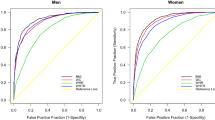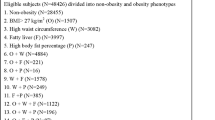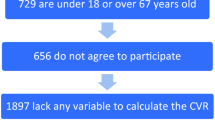Abstract
Objective:
To estimate the prevalence of metabolically healthy obesity (MHO) according to different definitions.
Methods:
Population-based sample of 2803 women and 2557 men participated in the study. Metabolic abnormalities were defined using six sets of criteria, which included different combinations of the following: waist; blood pressure; total, high-density lipoprotein or low-density lipoprotein-cholesterol; triglycerides; fasting glucose; homeostasis model assessment; high-sensitivity C-reactive protein; personal history of cardiovascular, respiratory or metabolic diseases. For each set, prevalence of MHO was assessed for body mass index (BMI); waist or percent body fat.
Results:
Among obese (BMI ⩾30 kg/m2) participants, prevalence of MHO ranged between 3.3 and 32.1% in men and between 11.4 and 43.3% in women according to the criteria used. Using abdominal obesity, prevalence of MHO ranged between 5.7 and 36.7% (men) and 12.2 and 57.5% (women). Using percent body fat led to a prevalence of MHO ranging between 6.4 and 43.1% (men) and 12.0 and 55.5% (women). MHO participants had a lower odd of presenting a family history of type 2 diabetes. After multivariate adjustment, the odds of presenting with MHO decreased with increasing age, whereas no relationship was found with gender, alcohol consumption or tobacco smoking using most sets of criteria. Physical activity was positively related, whereas increased waist was negatively related with BMI-defined MHO.
Conclusion:
MHO prevalence varies considerably according to the criteria used, underscoring the need for a standard definition of this metabolic entity. Physical activity increases the likelihood of presenting with MHO, and MHO is associated with a lower prevalence of family history of type 2 diabetes.
This is a preview of subscription content, access via your institution
Access options
Subscribe to this journal
Receive 12 print issues and online access
$259.00 per year
only $21.58 per issue
Buy this article
- Purchase on Springer Link
- Instant access to full article PDF
Prices may be subject to local taxes which are calculated during checkout



Similar content being viewed by others
References
Adams KF, Schatzkin A, Harris TB, Kipnis V, Mouw T, Ballard-Barbash R et al. (2006). Overweight, obesity, and mortality in a large prospective cohort of persons 50 to 71 years old. N Engl J Med 355, 763–778.
Aguilar-Salinas CA, García EG, Robles L, Riaño D, Ruiz-Gomez DG, Garcia-Ulloa AC et al. (2008). High adiponectin concentrations are associated with the metabolically healthy obese phenotype. J Clin Endocrinol Metab 93, 4075–4079.
Ärnlöv J, Ingelsson E, Sundström J, Lind L (2010). Impact of body mass index and the metabolic syndrome on the risk of cardiovascular disease and death in middle-aged men. Circulation 121, 230–236.
Brochu M, Tchernof A, Dionne IJ, Sites CK, Eltabbakh GH, Sims EA et al. (2001). What are the physical characteristics associated with a normal metabolic profile despite a high level of obesity in postmenopausal women? J Clin Endocrinol Metab 86, 1020–1025.
Deurenberg P (2001). Universal cut-off BMI points for obesity are not appropriate. Br J Nutr 85, 135–136.
Firmann M, Mayor V, Marques-Vidal P, Bochud M, Pécoud A, Hayoz D et al. (2008). The CoLaus study: a population-based study to investigate the epidemiology and genetic determinants of cardiovascular risk factors and metabolic syndrome. BMC Cardiovasc Disord 8, 6.
Foerster M, Marques-Vidal P, Gmel G, Daeppen JB, Cornuz J, Hayoz D et al. (2009). Alcohol drinking and cardiovascular risk in a population with high mean alcohol consumption. Am J Cardiol 103, 361–368.
Ghosh S, Meister D, Cowen S, Hannan WJ, Ferguson A (1997). Body composition at the bedside. Eur J Gastroenterol Hepatol 9, 783–788.
Janssen I, Katzmarzyk PT, Ross R (2004). Waist circumference and not body mass index explains obesity-related health risk. Am J Clin Nutr 79, 379–384.
Karelis AD (2008). Metabolically healthy but obese individuals. Lancet 372, 1281–1283.
Karelis AD, Brochu M, Rabasa-Lhoret R (2004). Can we identify metabolically healthy but obese individuals (MHO)? Diabetes Metab 30, 569–572.
Karelis AD, Faraj M, Bastard JP, St-Pierre DH, Brochu M, Prud’homme D et al. (2005). The metabolically healthy but obese individual presents a favorable inflammation profile. J Clin Endocrinol Metab 90, 4145–4150.
Karelis AD, Rabasa-Lhoret R (2008). Inclusion of C-reactive protein in the identification of metabolically healthy but obese (MHO) individuals. Diabetes Metab 34, 183–184.
Kelly T, Yang W, Chen CS, Reynolds K, He J (2008). Global burden of obesity in 2005 and projections to 2030. Int J Obes (Lond) 32, 1431–1437.
Kuk JL, Ardern CI (2009). Are metabolically normal but obese individuals at lower risk for all-cause mortality? Diabetes Care 32, 2297–2299.
Lean ME, Han TS, Morrison CE (1995). Waist circumference as a measure for indicating need for weight management. Br Med J 311, 158–161.
Lynch LA, O’Connell JM, Kwasnik AK, Cawood TJ, O’Farrelly C, O’Shea DB (2009). Are natural killer cells protecting the metabolically healthy obese patient? Obesity (Silver. Spring) 17, 601–605.
Marques-Vidal P, Bochud M, Mooser V, Paccaud F, Waeber G, Vollenweider P (2008a). Prevalence of obesity and abdominal obesity in the Lausanne population. BMC Public Health 8, 330.
Marques-Vidal P, Cambou JP, Nicaud V, Luc G, Evans A, Arveiler D et al. (1995). Cardiovascular risk factors and alcohol consumption in France and Northern Ireland. Atherosclerosis 115, 225–232.
Marques-Vidal P, Montaye M, Haas B, Bingham A, Evans A, Juhan-Vague I et al. (2001). Relationships between alcoholic beverages and cardiovascular risk factor levels in middle-aged men, the PRIME Study. Prospective Epidemiological Study of Myocardial Infarction Study. Atherosclerosis 157, 431–440.
Marques-Vidal P, Pécoud A, Hayoz D, Paccaud F, Mooser V, Waeber G et al. (2008b). Prevalence of normal weight obesity in Switzerland: effect of various definitions. Eur J Nutr 47, 251–257.
Marques-Vidal P, Pécoud A, Hayoz D, Paccaud F, Mooser V, Waeber G et al. (2009). Normal weight obesity: Relationship with lipids, glycaemic status, liver enzymes and inflammation. Nutr Metab Cardiovasc Dis (e-pub ahead of print 10 September 2009).
Martin A, O’Sullivan AJ, Brown MA (2001). Body composition and energy metabolism in normotensive and hypertensive pregnancy. BJOG 108, 1263–1271.
Meigs JB, Wilson PW, Fox CS, Vasan RS, Nathan DM, Sullivan LM et al. (2006). Body mass index, metabolic syndrome, and risk of type 2 diabetes or cardiovascular disease. J Clin Endocrinol Metab 91, 2906–2912.
Messier V, Karelis AD, Prud’homme D, Primeau V, Brochu M, Rabasa-Lhoret R (2009). Identifying Metabolically Healthy but Obese Individuals in Sedentary Postmenopausal Women. Obesity (Silver Spring) 18, 911–917.
Messier V, Malita FM, Rabasa-Lhoret R, Brochu M, Karelis AD (2008). Association of cardiorespiratory fitness with insulin sensitivity in overweight and obese postmenopausal women: a Montreal Ottawa New Emerging Team study. Metabolism 57, 1293–1298.
Paradis AM, Perusse L, Godin G, Vohl MC (2008). Validity of a self-reported measure of familial history of obesity. Nutr J 7, 27.
Rissanen A, Hakala P, Lissner L, Mattlar CE, Koskenvuo M, Rönnemaa T (2002). Acquired preference especially for dietary fat and obesity: a study of weight-discordant monozygotic twin pairs. Int J Obes Relat Metab Disord 26, 973–977.
Seidell JC (2000). Obesity, insulin resistance and diabetes--a worldwide epidemic. Br J Nutr 83 (Suppl 1), S5–S8.
Simpson JA, Lobo DN, Anderson JA, Macdonald IA, Perkins AC, Neal KR et al. (2001). Body water compartment measurements: a comparison of bioelectrical impedance analysis with tritium and sodium bromide dilution techniques. Clin Nutr 20, 339–343.
St-Pierre AC, Cantin B, Mauriège P, Bergeron J, Dagenais GR, Després JP et al. (2005). Insulin resistance syndrome, body mass index and the risk of ischemic heart disease. CMAJ 172, 1301–1305.
Stefan N, Kantartzis K, Machann J, Schick F, Thamer C, Rittig K et al. (2008). Identification and characterization of metabolically benign obesity in humans. Arch Intern Med 168, 1609–1616.
Steiner MC, Barton RL, Singh SJ, Morgan MD (2002). Bedside methods versus dual energy X-ray absorptiometry for body composition measurement in COPD. Eur Respir J 19, 626–631.
Wildman RP, Muntner P, Reynolds K, McGinn AP, Rajpathak S, Wylie-Rosett J et al. (2008). The obese without cardiometabolic risk factor clustering and the normal weight with cardiometabolic risk factor clustering: prevalence and correlates of 2 phenotypes among the US population (NHANES 1999-2004). Arch Intern Med 168, 1617–1624.
Wolf HK, Kuulasmaa K, Tolonen H, Ruokokoski E (1998). Participation Rates, Quality of Sampling Frames and Sampling Fractions in the MONICA Surveys.. WHO MONICA: Helsinki, Finland.
Yanbaeva DG, Dentener MA, Creutzberg EC, Wesseling G, Wouters EF (2007). Systemic effects of smoking. Chest 131, 1557–1566.
Acknowledgements
The CoLaus study was supported by research grants from GlaxoSmithKline, the Faculty of Biology and Medicine of Lausanne, Switzerland and the Swiss National Science Foundation (Grant no. 33CSCO-122661). PV and GW received an unrestricted grant for GSK to build the CoLaus sudy. We thank Dr Vincent Mooser (Medical Genetics, GlaxoSmithKline, Philadelphia, PA, USA) and the EJCN reviewers for helpful comments. We also express their gratitude to the participants in the Lausanne CoLaus study and to the investigators who have contributed to the recruitment, in particular Yolande Barreau, Anne-Lise Bastian, Binasa Ramic, Martine Moranville, Martine Baumer, Marcy Sagette, Jeanne Ecoffey and Sylvie Mermoud for data collection.
Author information
Authors and Affiliations
Corresponding author
Ethics declarations
Competing interests
The authors declare no conflict of interest.
Additional information
Supplementary Information accompanies the paper on European Journal of Clinical Nutrition website
Rights and permissions
About this article
Cite this article
Velho, S., Paccaud, F., Waeber, G. et al. Metabolically healthy obesity: different prevalences using different criteria. Eur J Clin Nutr 64, 1043–1051 (2010). https://doi.org/10.1038/ejcn.2010.114
Received:
Revised:
Accepted:
Published:
Issue Date:
DOI: https://doi.org/10.1038/ejcn.2010.114
Keywords
This article is cited by
-
Association of metabolically healthy obesity in young adulthood with myocardial structure and function
International Journal of Obesity (2023)
-
Relevance of body composition in phenotyping the obesities
Reviews in Endocrine and Metabolic Disorders (2023)
-
Exploring metabolically healthy obesity: prevalence, characteristics, and cardiovascular risk in the Iranian population based on the STEPS 2021
Journal of Diabetes & Metabolic Disorders (2023)
-
Prevalence rates of metabolic health and body size phenotypes by different criteria and association with insulin resistance in a Maltese Caucasian population
BMC Endocrine Disorders (2022)
-
Uric acid as a predictor of weight gain and cardiometabolic health in the Study of Novel Approaches to Weight Gain Prevention (SNAP) study
International Journal of Obesity (2022)



